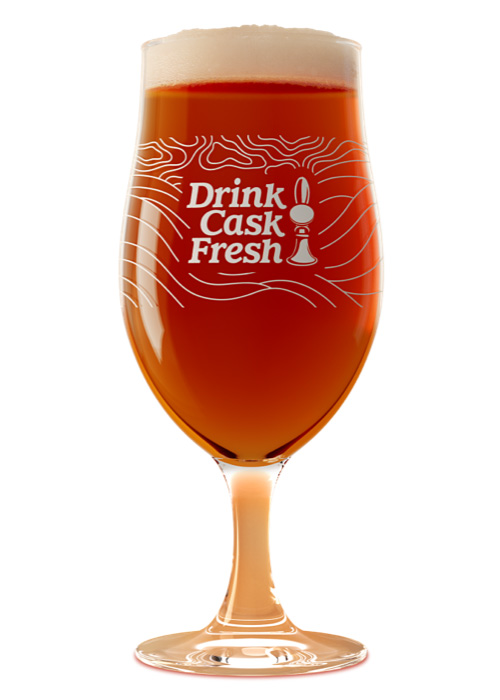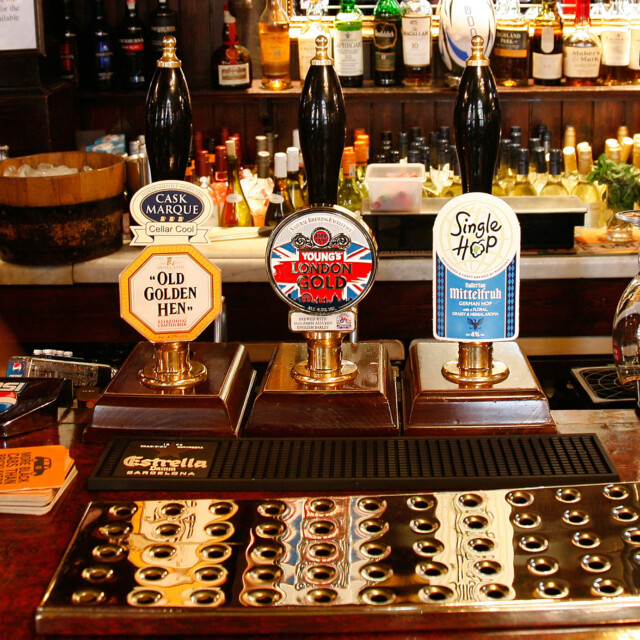Dozens of London pubs have acquired a new decorative feature this summer. On bar tops across the city stand vaguely old-fashioned, totem pole-like objects amid serried ranks of colorful keg fonts. These are handpumps, traditionally used to serve cask ale — for so long a staple in this country. But in many of the British capital’s pubs, they’re now purely for show.
Covid-19 has been hard on cask ale, the “warm” British beer that completes its fermentation in the serving vessel. This is how it acquires its distinctive soft carbonation, a key part of what makes it so enjoyable and such a contrast to keg beer, which generally has carbon dioxide added from an outside source. Cask needs to be drunk quickly, within three days of being breached, because when beer is pumped out of the cask, air enters. Also known as “Real Ale,” a term coined by consumer organization the Campaign for Real Ale (CAMRA) in the 1970s, it’s best enjoyed at cellar temperature, around 53 degrees Fahrenheit, not chilled like keg.
According to the British Beer & Pub Association, cask beer in 2021 accounted for just 4.3 percent of overall beer sales, and around 15 percent of draft sales. Sales have nearly halved in the past eight years — cask made up 8.3 percent of overall sales in 2015 — but the biggest drop has come post-Covid.
There are as many explanations as there are cask drinkers as to why sales have dropped, but some would point the finger at American-style craft beer — a term which, in the U.K., tends to be more about vibes than independence or even beer style, but invariably means keg. Sales are booming, matching and, in value terms, surpassing those of cask.
Craft’s poster boy is Beavertown Neck Oil, a London-brewed, sessionable, New World-hopped keg pale ale that, with the considerable financial backing of owners Heineken, has rapidly become one of the U.K.’s handful of genuinely national craft beer brands.
It’s no wonder a cross-industry campaign, Drink Cask Fresh, has launched to lure drinkers back to cask. But will it make a difference?
Follow the Money
Few people know cask ale better than Georgina Young. The former head brewer at Fuller’s, London’s last Victorian brewery, is now in charge at St Austell in Cornwall, one of Britain’s top cask ale producers, which makes around 97,500 U.S. beer barrels (70,000 British barrels) a year and accounts for some 50 percent of the brewery’s output. She says that cask sales are slightly down this year, confounding expectations that tentative post-Covid growth would accelerate in 2023.
The problem, perhaps, is that many of cask ale’s most loyal drinkers — many of them older — haven’t returned to old habits. “Some people are still nervous to be in pubs,” Young says. “Many pubs just don’t have the same footfall as before.”
Some of Britain’s biggest family breweries are turning their attention elsewhere. Greene King, the only brewery in the top 10 of the U.K.’s leading industry publication The Morning Advertiser’s cask and craft lists, told the Daily Telegraph earlier this year that its focus was moving away from cask toward keg beers, such as its Icebreaker Pale Ale.
“Pre-Covid, people were already talking about cask being in decline, and what could be done? Covid may have accelerated that, but I don’t think it fundamentally changed anything.”
One of the issues for breweries is that cask ale tends to sell for less than keg beer, a reflection of its historic (but not current) position as the working man’s drink, and the fact that producing it can be cheaper.
“It’s a really big challenge,” says Theo Freyne, owner of Deya Brewing Company, where cask makes up only 3 or 4 percent of overall output, and where Steady Rolling Man, a delicate, hop-focused opaque pale ale packaged almost exclusively in keg and can, makes up more than half of all sales. “Normally you make a beer and calculate the proper margin, but cask cannot be over a certain price or it will not sell.”
Cask’s most persistent problem — quality at the point of service — is entwined with this. Customers are wary of paying top dollar for a product that may or may not be sold in peak condition, while publicans — so the argument goes — are less likely to give it the attention it needs when their margin is so slim. In the meantime, too much flabby ale is being served because it doesn’t sell fast enough.
The Covid Bounce
High prices are clearly not a barrier for drinkers of either Neck Oil or Guinness, the two major beneficiaries of the new era in British pubs. The former can go for as much as a once unimaginable 8 pounds ($10) a pint in London, while you only have to speak to publicans for five minutes to hear grumbles about the growing cost of a keg of Guinness.
Both have benefitted from drinkers’ post-Covid desire for a more premium, “pub-only” experience. Indeed, according to owners Diageo, Guinness even became Britain’s No. 1 pub pint for a period at the end of last year. Cask ale should fit comfortably into that category, but it has neither the financial backing nor the consistency of presentation that make Guinness, for example, such a cultural behemoth.
“Compared to any other beer on the bar, cask lacks theater; the way it’s served doesn’t compare to a beer like Guinness.”
Cask’s greatest advocate, CAMRA, also suffered during the pandemic. According to chief executive Tom Stainer, the group was in touching distance of 200,000 members in 2019; now it’s somewhere between 150,000 and 160,000, the result of natural churn and the lack of festivals, CAMRA’s great recruiting ground, for more than a year.
Stainer points out that the lower margin publicans earn on cask makes it less appealing now that finances are stretched to breaking point, but adds that the pandemic cannot be blamed entirely. “Pre-Covid, people were already talking about cask being in decline, and what could be done?” he says. “Covid may have accelerated that, but I don’t think it fundamentally changed anything.”
Mixed Streams
Cask and craft can coexist quite happily. Many of Britain’s best modern breweries — including Verdant, Cloudwater, The Kernel and Deya — have recently turned (or returned) to cask ale, an acknowledgement of its unique place in British beer culture.
And cities like Manchester and Leeds, as their advocates frequently point out, boast the best of both worlds. The latter demonstrates what modern British beer culture looks like at its best: It’s full of craft beer venues, including what was probably Britain’s first, North Bar, opened in 1997, and it has a robust cask ale tradition.
No brewery exemplifies this more than Kirkstall, also in Leeds. Around 60 percent of its output is cask but its biggest brand is Virtuous, a session IPA that, in terms of flavor and strength, is similar to Neck Oil. It’s a successful mix: According to head brewer Will Inman, the brewery’s output has grown year-on-year since he joined in 2017, to an anticipated 20,000 hectoliters this year.

Kirkstall’s happy blend of cask ale and modernity is not too far from where the Drink Cask Fresh campaign is pitched. Backed by brewers, pub groups, and industry organizations, it aims to change the image of cask beer courtesy of a bold color palette, the tagline “Drink the Freshest Beer on the Bar,” and by offering cask drinkers the sort of pub experience — from position on the bar to glassware — normally associated with multinational beer brands. The pilot scheme ended in May, with hopes that a bigger campaign will kick off later this year.
“The pilot really highlighted the need for a category campaign,” says project manager and beer writer Pete Brown. He says that how cask is poured and presented to the customer is a particular issue. “Compared to any other beer on the bar, cask lacks theater; the way it’s served doesn’t compare to a beer like Guinness,” he says.
Cask Adrift?
There are signs that the tide may, very tentatively, be turning. Those craft producers that make cask do so not out of a sense of duty, but because — as in the case of Deya — they really like it. “I love drinking traditional cask beers,” Freye says.
He’s not alone. Kirstall recently hosted a festival devoted to traditional beer styles (“The Great Exhibition of Prize Ales”), while Dark Mild, once the least fashionable of all beers, is increasingly common in British pubs. Some family breweries, such as Timothy Taylor and Harvey’s, have bucked cask’s decline. (It’s perhaps not a surprise that they are among the more stubbornly traditional of Britain’s historic breweries.)
Cask is not about to disappear, but its travails might precipitate a much-needed acceptance of its real place in modern British beer culture. Long ago supplanted by canned lager as the ordinary Briton’s beer of choice, it’s increasingly something for aficionados, the draft equivalent of Belgium’s marvelous bottled beers. That’s hard to square, though, with it being the cheapest pint on the bar.
Ironically, the popularity of hop-heavy, American-style craft beer may show a way forward, according to Brown. “It demonstrates there’s a huge thirst for light hoppy ales — that not everyone just wants lager,” he says. “That’s an opportunity.”
This story is a part of VP Pro, our free platform and newsletter for drinks industry professionals, covering wine, beer, liquor, and beyond. Sign up for VP Pro now!
